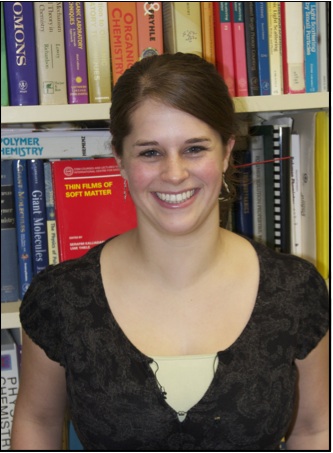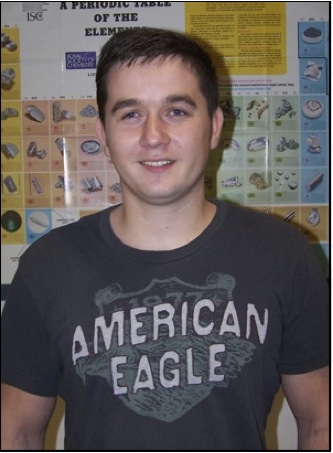2011 Capstone Celebration Symposium
PLU Chemistry Department
May 2nd to May 6th, 2011
Join the Chemistry Department to hear the senior capstone presentations. Student presentations will occur Monday through Friday. The schedule of talks with more details is given below.
[ Monday | Tuesday | Wednesday | Thursday | Friday ]
Morken Center, Room 103
12:40 pm - Comparing Capacitances of Electrodes with Ordered & Disordered Pore Geometries
Erin Madden, Senior Capstone Seminar
There is a discrepancy in the literature whether porous carbon electrodes store more electrochemical capacitance with a disordered or an ordered pore design. However, these materials have not been made comparably, so their capacitances cannot be fairly compared. We hypothesize that if we control the physical and electrochemical properties of disordered and ordered porous carbon electrodes, then the electrodes should have comparable amounts of capacitance regardless of pure geometry. To test this, we synthesized a carbon inverse opal papers from PMMA colloidal crystal templates and compared it to a carbon nanofoam paper. We deliberately designed both carbon nanomaterials to have similar average pore sizes; surface chemistries; electronic conductivities; and electrode thicknesses. However, recent experiments indicate that the nanofoams and inverse opals have dramatically different surface areas. (554 + 7 m2/g vs. 190 + 2 m2/g respectively). As a result, the nanofoam has an electrochemical capacitance of 40 + 11 11 Fg-1, and the inverse opal 11 + 13 13 Fg-1. Future experiments will focus on closing the gap in surface area and making the pore geometries of the inverse opals more reproducible.

1:50 pm - Determining a Binding Coefficient of CdSe Nanocrystals with NMR
Joshua Siverson, Senior Capstone Seminar
Current literature suggests that a broadening in NMR peaks for ligand on CdSe nanocrystals is caused by the rapid association and disassociation of the ligand onto the surface of the crystal. This research aimed to replicate the literature data and determine if the NMR peak broadening was a result of kinetics. This was done by lowering the temperature in the NMR while the sample ran, effectively slowing the kinetics and should have increased peak definition. Data collected thus far in time indicates that peak definition is independent of temperature and more dependent on ligand concentration.

2:30 pm - Binding Studies on Second Order Non-Linear Optical Chromophores and Deoxyribonucleic Acid
Luke Latimer, Senior Capstone Seminar
Matrix assisted poling is a promising technique for improving acentric ordering of chromophores in organic non-linear optical (NLO) materials. The possibility of deoxyribonucleic acid functioning as an effective host material for enhancing acentric ordering by dye intercalation between base pairs is investigated. A dye, LL-1, which is predicted to intercalate and have moderate NLO activity, was synthesized. Through UV-Vis spectroscopy, it was determined that no readily available NLO dyes intercalate into DNA, but crude LL-1 likely does. Additionally, no dyes, including the positive control, ethidium bromide, showed binging to alcohol soluble CTAB-DNA, which is synthesized by precipitating Na-DNA in the presence of cetyl trimethyl ammonium bromide.

3:20 pm - Characterization of Polß and Polß-PAK, Two Mitochondrial Polymerases from the Parasite Trypanosoma brucei
Matt Fischer, Senior Capstone Seminar
Trypanosoma brucei is the causative parasite of African sleeping sickness. Trypanosomes are unique eukaryotes in that their mitochondria contain kDNA, a chainmail like structure composed of maxi and mini circles. Our research focuses on two polymerases pol b and pol b-PAK, that are utilized by the parasite in mini circle replication. Polymerase activity, effects of salt concentration, and the significance of the PAK domain were investigated.

Synthesis of a Novel Copolymer Linker
Eric Boze, Senior Capstone Seminar
Transition from radical to TRP methods of polymer synthesis traditionally involves highly reactive intermediate species that tend to reduce yield. Development of a new methods to transition between synthetic strategies will increase overall copolymer synthesis yields and reduce contaminating side reactions. The first purified intermediate generated by hydrogenation of an alkynyl stannane is confirmed by NMR spectroscopy, and upon separation from starting product the will be completed in two steps, involving a Stille cross coupling and grignard reaction.

1:50 pm Making Corey-Fuchs reaction catalytic in triphenylphosphine or triphenylarsine surrogate
Lee Palosh, Senior Capstone Seminar
The Corey-Fuchs reaction is one of the few that can be utilized to make an alkyne functional group. Similar to the Wittig reaction in which an alkene is produced, the reaction uses large amounts triphenylphosphine for the first step of the conversion. Catalytic methods have been widely used for the Wittig reaction by substituting triphenylarsine for triphenylphosphine to reduce the amount of waste generated. This concept was adopted to create a catalytic Corey-Fuchs reaction by using triphenylarsine. However, the synthesis of the desired product was not achieved when using 4-bromobenzaldehyde and either triphenylphosphine or triphenylarsine. Attempted variations of the reaction in terms of reaction time and temperature profiles did not produce the desired product. Characterizing the products of the reactions via IR and GC/MS showed only the presence of starting materials.

2:30 pm - A Look into Greener Chemistry: Modification of the Corey-Fuchs Reaction for the use of Palladium Catalysts
Mark Lindsey, Senior Capstone Seminar
The Corey-Fuchs reaction is one of the most interesting reactions in organic synthesis world for it is a way to convert an aldehyde into an alkyne. However, the mechanism for this reaction involves the use of large amounts of triphenylphosphine and n-BuLi which are very hazardous materials for the environment. Through the use of catalysts, this reaction could be made to produce less waste and use different, less hazardous starting materials. A Heck reaction was used in order to test this hypothesis on 1,1-dibromoalkene compounds that were created in accordance to the first half of the reaction. No products were successfully synthesized and characterization of the reaction by NMR and GC-MS showed only the presence of starting materials.

3:20 pm - Surface Coating of Magnetic Iron Oxide Nanoparticles for use in Biomedicine
Krista Sparks, Senior Capstone Seminar
Two studies investigating the preparation of iron oxide nanoparticles for optimum performance in biomedical applications are reviewed. Surface modification of iron oxide nanoparticles in ferrofluids was studied for use as contrast agents in magnetic resonance imaging (MRI). Physical characterization of the ferrofluids was performed using dynamic light scattering (DLS), transmission electron microscopy (TEM), x-ray powder diffraction (XRD) Fourier-Transform Infrared Spectroscopy (FT-IR) and relaxometric characterization was performed using NMR-dispersion profiles. Surface modification with silica was found to improve the ability of the ferrofluid to act as a contrast agent. In another study, surface modification of superparamagnetic iron oxide nanoparticles (SPIO-NPs) with folic acid and o-carboxymethyl chitosans (OCMCS) was investigated for biocompatibility and targeting of specific tumor cells. Characterization of the nanoparticles was performed using FT-IR, XRD, TEM and DLS, and cell targeting was observed using Prussian blue staining and MRI in mice. The modified nanoparticles were found to decrease cytotoxicity and macrophage cell capture and increase colloidal stability and hydrophilic properties in mice suggesting beneficial use in specific tumor targeting.

4:00 pm - Synthesis and Reactivity of 2-ethenyl-2-cyclohexenol
Emily Tollefson, Senior Capstone Seminar
It is proposed that masking the electron withdrawing group of highly activated 2-formal- or 2-keto-1, 3, -butadienes as 2-hydroxymethyl or 2-hydroxymethylene groups, resp., would allow their Diels-Alder reactions to proceed readily under oxidizing conditions in the presence appropriate dienophiles. The synthesis of a model compd., 2-ethenyl-2-cyclohexenol, was accomplished through two routes. The first pathway was a Stille cross-coupling of 2-iodo-2-cyclohexenol with vinyltributyltin under palladium(O) catalysis. The desired conversion was achieved; however, the diene could not be isolated cleanly from the remaining organotin residue. The second pathway was a Suzuki-Miyaura cross-coupling of 2-iodo-2-cyclohexen-1-ol with O’Shea’s reagent. This reaction afford high levels of conversion (¬ª90%) with few byproducts. Preliminary results of the Diels-Alder reaction of 2-ethenyl-2-cyclohexenol occurs under mild oxidizing conditions with N-Phenylmaleimide.

12:40 pm - Percent Composition by Mass of Polystyrene/polybutadiene copolymers
Rob Pepin, Senior Capstone Seminar
Using size exclusion Chromatography with a multi-detector setup to determine percent composition by mass of polystyrene-butadiene copolymers is demonstrated.

1:50 pm - Development of a versatile synthetic method for the production of N-mono and N,N-disubstituted N'-hycroxyureas using an unprotected hydroxycarbamate
Sam Whedon, Senior Capstone Seminar
Substituted N-hydroxyureas have demonstrated medicinal, biological, and industrial applications. Many synthetic paths for the production of N-alkyl-N, ‘-hydroxyureas rely on either isocyanate starting materials or intermediates, which prohibits the production of N,N-disubstituted-N’-hydroxyureas. Phosgene and its derivatives are also utilized as starting materials in many literature preparations of N-alkyl-N’-hydroxyureas; however, the reactivity of these starting materials requires strict control of reaction conditions. Synthesis of N-alkyl-N’-hydroxyureas and N,N-diakyl-N-hydroxyureas from O-phenyl-N-hydroxycarbamate allows for the production of mono- and di-substituted hydroxyureas in mild conditions. The starting material, O-phenyl-N-hydroxycarbamate, is stable in water, and does not require hydroxyl protection, both of which render it more versatile than other carbamate starting materials. Synthesis by this method has allowed for the successful production of hydroxyureas N-substituted with pyrrolidine, morpholine, diethylamine, methylamine and benzylamine. Optimization is ongoing, but the success of syntheses from amines with a variety of steric and electronic substituent groups suggests that this method could be successful with a wide array of primary and secondary amines.

2:30 pm - The Effects of Ligands on Cadmium Selenide Nanocrystals
Kelsey Weigley, Senior Capstone Seminar
Attaching ligands to the surface of quantum dots alters their photo-luminescence. In this study, these effects are demonstrated and compared through the addition of ligands on the surface both cadmium selenide nanospheres and nanobelts. Particular attention is paid to the addition of trioctylphosphine oxide ligands. The effectiveness of using 99% trioctylphosphine and 90% trioctylphosphine oxide in this process in compared. Literature suggests that the phosphonic acid impurities found in the lower grade trioctylphosphine oxide may modify how the ligand interacts with the nanocrystals. Initial results show that the two grades of trioctylphosphine oxide do have differing effects on the photo-luminescence of the nanocrystals.

3:20 pm - Analysis of trisubstituted arsines as replacements for triphenylphosphine within the Wittig and Mitsunobu reactions
Erik Arnits, Senior Capstone Seminar
The Wittig and Mitsunobu reactions both traditionally depend on triphenylphosphine as an essential reagent. The Witting reaction is one the most useful to make olefins due to its unambiguous positioning and stereoselectivity of the double bond. Additionally, the Mitsunobu reaction has proven to be a powerful tool within organic and medicinal chemistry for its use in creating many types of stereospecific bonds, including C-O, C-S, C-N and C-C. It is therefore very important that we seek to develop more efficient ways to perform the Witting or Mitsunobu reaction. Results and direction on finding ways to catalyze these reactions and create little to zero hazardous waste have been investigated.

4:00 pm - Synthesizing Proton Exchange Membranes and Observing Proton Conductivity in Fuel Cells: A Review
Jonah Oh, Senior Capstone Seminar
Fuel cells are electrochemical instruments that are able to convert chemical energy to electrical energy. This electrical energy can be used to supply power towards applications such as automotive transportation to buildings. One of the chief factors that hinder fuel cell development is the proton exchange membrane. This presentation will review the various synthetic routes research groups have conducted and how they have been able to affect the mobility of protons in these membranes based on doping concentrations, temperature, and humidity.

1:50 pm - Investigation of copolymer compatiblization in bulk polymer blends characterized by solid-state NMR.
Jessica Dottl, Senior Capstone Seminar
Polymer blends are highly relevant industrial materials, and the ability to tailor polymer blends to possess particular properties is very important. Polymer blends of low molecular weight polystyrene (PS) and polybutadiene (PB) were investigated by using a 500 MHz NMR and solid-state NMR techniques. The effectiveness of different copolymers as compatibilizers was studied using deuterated PS in the polymer blend. This approach probes information related to the location of a copolymer in a polymer blend by measuring the effectiveness of cross-polarization with respect to the aromatic and aliphatic regions of PS. Preliminary data from 13C cross-polarization magic angle spinning (CPMAS) experiments indicates that there is greater cross-polarization transfer in a blend compatibilized with a random copolymer than in a blend compatibilized with a diblock copolymer.

2:30 pm - Nickel-Catalyzed Oxidative Cross-Coupling Reactions of Imidazoles with Terminal Alkynes Using Oxygen as the Oxidant
Vlad Sydorenko, Seni0r Capstone Seminar
There is evidence in the literature for the heterocoupling between different terminal alkynes. Cross-coupling reactions between oxazoles with terminal alkynes are also known. However, there is no evidence of cross-coupling of imidazoles with terminal alkynes under oxidative catalytic system. It is proposed that the cross-coupling of imidazole derivatives with terminal alkynes using nickel-based catalysts in the presence of molecular oxygen will result in the formation of a cross-coupled product. The two catalytic systems involving copper and nickel catalysts were developed to test our hypothesis. The synthesis of the desired product was not achieved with either copper or nickel catalysts when potassium tert-butoxide was used as the base. By using lithium tert-butoxide, homocoupling product was seen as well as the unexpected ester-tert-butyl phenyl acetate. Its appearance was confirmed by GC/MS and it was separated by Column Chromatography. The reaction resulted in low yield and the identity of our ester was confirmed by NMR and IR spectroscopy.

3:20 pm - Synthesis of S,N-thiocarbamates, N,N'-hydroxyureas, and N,N'-dihydroxyurea
Erin Johnson, Senior Capstone Seminar
Hydroxyurea analogs have been previously proposed to be treatments of sickle cell disease. Synthesis methods of some hydroxyurea analogs were developed in order to optimize reaction conditions. In particular, S-methyl-N-butylthiocarbamate, S-methyl-N-isoproplythiocarbamate and N,N’-isopropylhydroxyurea were successfully synthesized using S,S-dimethyl dithiocarbamate (DMDTC) and the corresponding primary amine. These compounds were made with good yields (52%, 64%, and 82% respectively) and purities. Di-benzyl-protected dihydroxyurea was also synthesized by reacting DMDTC with two equivalents of O-benzylhydroxylamine. However, very low yields of this compound were obtained (<12%), and the structure this product was unable to be confirmed using NMT, IR and GGC-MS spectra. This showed that more research must be conducted in order to optimize this reaction.

4:00 pm - Attempting to Elucidate the Isomerization Mechanism of a Sulfonamide Derivative of Glutathione
Joshua Sloan, Senior Capstone Seminar
Glutathione (GSH) is an antioxidative tripeptide found in biological systems. Neutrophils, a type of immune cell, produce hypochlorous acid as part of their normal activity when responding to infection or injury. GSH reacts with hypochlorous acid to produce a sulfonamide product (GSA) whose structure has already been determined by another research group. This group determined that GSA exists as two diastereomers due to epimerization of a proton and carboxylic acid group and proposed a mechanism for how the isomerization occurs. This research project sought to confirm the proposed mechanism by using sodium borohydride to isolate the proposed imine intermediate. One and two dimensional NMR studies were conducted. As of now, the mechanism has not been fully determined but progress is being made and any additional results will be presented. Developing an understanding of GSA could allow its use as a biomarker during infection or injury to monitor neutrophil activity.

1:10 pm - Correlation between catalyzed rate of reaction and rate of radical production with structural mutations in Complex III
Patrick Kunkel, Senior Capstone Seminar
Complex Ill, also known as the bc1 complex, is a transmembrane protein complex in the electron transport chain of mitochondria. The enzymes role is to generate a proton gradient within compartments of the mitochondria and to oxidize coenzyme Q. An important part of this process is how the bc1 complex deals with the radical anion form of coenzyme Q which can in some cases lead to the production of radical species. By using various mutated bc1 complexes the relationship between the catalyzed rates of reaction and rate of radical production can be correlated with structural alterations in the active site.

1:50 pm - Synthesis and Physical Properties of Dicarboximide-Functionalized Oxanorbornyl Polymers
Adrienne Hollister, Senior Capstone Seminar
Several novel and potentially useful polymers and copolymers were synthesized via ring opening metathesis polymerization under living conditions using a Grubbs third generation catalyst. The polymers were characterized by gel permeation chromatography using polystyrene standards. Their polydispersity (PD) values were generally narrow (PD<1.1). Glass transition temperatures were measured and found to vary significantly with respect to side chains. The highest glass transition temperature was observed for polymers with a phenyl side chain, and the lowest we observed for polymers containing a five-carbon diether side chain. The glass transition temperatures of the polymers decreased with larger and more flexible side chains. Diblock copolymers gave two transition temperatures approximately equivalent to those of the corresponding homopolymers. The characteristics of thin film polymer samples on a silicate surface were also examined by Atomic Force Microscopy.

3:40 pm - Isolation and Characterization of DNA Polymerase Beta and DNA Polymerase Beta-PAK in Trypanosoma brucei
Luke Hansen, Senior Capstone Seminar
DNA Polymerase Beta and DNA Polymerase Beta-Pak are two not well understood proteins involved in the mitochondrial DNA replication cycle of the parasite Trypanosoma brucei. Optimizing protein expression conditions, isolation of protein by HisTag nickel column affinity chromatography, investigation of the PAK domain by ligation reactions, and optimal polymerase activity in varying salt conditions by gel filtration chromatography were all investigated. Literature suggests optimal polymerase activity occurs in higher salt environments for DNA Polymerase Beta-PAK but no conformational change was detected using the gel filtration chromatography method.





Social Media